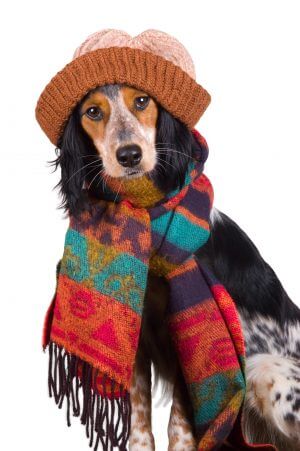 Even if you live in hot and sunny climates such as Arizona, Florida and California, the temperatures can dip and get below freezing at night. If you live in colder spots throughout the country, you and your dog may have to battle the rain, ice and cold. During the winter season, many dogs feel the cold as much as their owners do, especially when they are not used to frigid temperatures.
Even if you live in hot and sunny climates such as Arizona, Florida and California, the temperatures can dip and get below freezing at night. If you live in colder spots throughout the country, you and your dog may have to battle the rain, ice and cold. During the winter season, many dogs feel the cold as much as their owners do, especially when they are not used to frigid temperatures.
Both puppies and older dogs are more vulnerable to colder temperatures than dogs in their prime years. Additionally, certain breeds of dogs are bred for the snow and cold. These include mastiffs, sheep dogs, Bernese mountain dogs, and Alaskan malamutes, for instance. And although your dog may have a fur coat, it does not help in the bitter cold. Know that dogs with a double coat are able to stay warmer than those with a single coat, as they lack an undercoat.
Here are some tips to ensure your dog keeps cozy and warm:
- Grooming. Avoid trimming, shaving or cutting your dog’s hair because a dog’s full weight coat is the only thing that keeps him warm in the winter. Keep your dog’s coat brushed as matted hair does not repel water as well. Good grooming habits can also eliminate dander if you live in a dry climate. Make sure you bathe your dog indoors and completely dry him before letting him/her outside. This will also help prevent respiratory infections or kennel cough.
- Paw pads. Keep your dog’s paws well-trimmed to avoid snow or ice accumulations from fur within the pads. If your dog’s paws are cracked consider buying some Vaseline or even paw protection wax to protect their paws even more. Booties also are an aid.
- Dogs that actively spend a lot of time outdoors during the winter need to be fed more food than they usually eat so they have the extra energy needed to keep them warm. This is NOT true for dogs that stay indoors.
- Always provide clean water in a bowl and make sure it doesn’t freeze. Also, don’t assume snow or ice will provide a good source of water.
- Buy sweaters, coats, hats, mittens and booties if you like to go for walks during the winter. Fleece linings provide additional warmth and comfort.
- Cold temperatures below 30 degrees are unsafe for your dog. Do not leave your dog outside for extended periods. If you have an outside dog house, be sure it is heated, dry and away from cold drafts. Provide plenty of blankets and pillows – a heated bed may also be a good option. As dogs get older, it is better for them to be inside or their arthritis will just get worse.
A good rule of thumb? If the outdoor temperature falls below freezing, you should not allow your dog to spend long periods of time outdoors, as low temperatures can cause frostbite and paw injuries. Check your dog’s ears and tail tip to see if they are cold, hard, or white, red or gray in color — these are all indications of frostbite, meaning a trip to the vet is inevitable.
Whether your dog is a puppy, a senior, or in between, keep him as healthy as possible!
